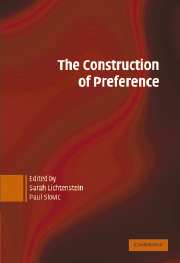Filed in
Books
 Subscribe
Subscribe to Decision Science News by Email (one email per week, easy unsubscribe)
IMPROVISED TASTES
Ever a students of improvisation, we are happy that Sarah Lichtenstein and Paul Slovic’s new edited volume The Construction of Preference is now out in earth-toned paperback, and that DSN editor’s modest contribution has made the cut.
BLURB
One of the main themes that has emerged from behavioral decision research during the past three decades is the view that people’s preferences are often constructed in the process of elicitation. This idea is derived from studies demonstrating that normatively equivalent methods of elicitation (e.g., choice and pricing) give rise to systematically different responses. These preference reversals violate the principle of procedure invariance that is fundamental to all theories of rational choice. If different elicitation procedures produce different orderings of options, how can preferences be defined and in what sense do they exist? This book shows not only the historical roots of preference construction but also the blossoming of the concept within psychology, law, marketing, philosophy, environmental policy, and economics. Decision making is now understood to be a highly contingent form of information processing, sensitive to task complexity, time pressure, response mode, framing, reference points, and other contextual factors.
CONTENTS
Part I. Introduction; Part II. Preference Reversals; Part III. Psychological Theories of Preference Reversals; Part IV. Evidence for Preference Construction; Part V. Theories of Preference Construction; Part VI. Affect and Reason; Part VII. Miswanting; Part VIII. Contingent Valuation; Part IX. Preference Management.
CONTRIBUTORS
Dan Ariely, Max H. Bazerman, James R. Bettman, Sally Blount, Jerome R. Busemeyer, Melissa L. Finucane, Baruch Fischhoff, Daniel T. Gilbert, Daniel G. Goldstein, Robin Gregory, David M. Grether, Sara D. Hodges, Keith J. Holyoak, Christopher K. Hsee, Sheena S. Iyengar, Ryan K. Jessup, Eric J. Johnson, Joseph G. Johnson, Daniel Kahneman, Kristen J. Klaaren, Daniel C. Krawczyk, Suzanne J. LaFleur, Mark R. Lepper, Sarah Lichtenstein, Douglas J. Lisle, George Loewenstein, Mary Frances Luce, Donald G. MacGregor, Douglas MacLean, Naomi Mandel, Henry Montgomery, Stephen M. Nowlis, John W. Payne, Ellen Peters, Charles R. Plott, Drazen Prelec, Matthew Rabin, Daniel Read, Ilana Ritov, Yuval S. Rottenstreich, Samuel Sattath, David A. Schkade, Jonathan W. Schooler, Eldar Shafir, Dan Simon, Itamar Simonson, Paul Slovic, Cass R. Sunstein, Ola Svenson, Richard H. Thaler, Amos Tversky, Elke U. Weber, Timothy D. Wilson, Yiheng Xi, Frank Yu, Robert B. Zajonc, Jiao Zhang
Filed in
Articles
 Subscribe
Subscribe to Decision Science News by Email (one email per week, easy unsubscribe)
DEFAULTS DO MATTER
Decision Science News and Eric Johnson have teamed up once again to write a piece for the Financial Times on the suprisingly powerful effect of defaults (even simple software defaults) on decisions, from the routine to the life-changing. Their conclusion? History gets written by default. The piece is called “The daily defaults that change lives” and you can read it here.
Filed in
Gossip
 Subscribe
Subscribe to Decision Science News by Email (one email per week, easy unsubscribe)
LEGERDEMAIN
Last year, DSN was grateful when the eight-figure-endowment Decision Science News Foundation won the bidding war for Decision Science News Tower (pictured). This year, we are pleased to announce that The Foundation has extended additional funds to provide a private domain name: decisionsciencenews.com
News readers who use newsreaders will be glad to know there is a new RSS feed as well:
http://www.decisionsciencenews.com/?feed=feed
FIND THE WONDER IN A NUMBER
The story goes that British mathematician G. H. Hardy was visiting the great Indian mathematician Srinivasa Ramanujan in the hospital. According to Hardy:
I had ridden in taxi cab number 1729 and remarked that the number seemed to me rather a dull one, and that I hoped it was not an unfavorable omen. “No,” he replied, “it is a very interesting number; it is the smallest number expressible as the sum of two cubes in two different ways.
Regardless of it being a logical fallacy, DSN belives that aping the habits of the great can make one great. Sometimes. So head over to a site where you can learn fasincating facts about numbers and perhaps end up the next Ramanujan.
The site is called coolnumbers.com and is run by Wharton’s Pete Fader a man of both both decision science and marketing. (Now that’s a cool combination.)
Filed in
Jobs
 Subscribe
Subscribe to Decision Science News by Email (one email per week, easy unsubscribe)
LONDON SCHOOL OF ECONOMICS OFFERS DECISION SCIENCE POSITION
There is a Lectureship or Senior Lectureship in Decision Sciences/Operational Research at LSE, but hurry because the closing date for receipt of applications is 18 August 2006.
The Operational Research Group has been established at LSE for over 50 years and has an international reputation in Decision Sciences, Mathematical Programming, and Public Policy. The Group is one of the core groups within the new Department of Management being created at LSE. This position is part of the significant development of research and teaching with new appointments of leading scholars in management. We are looking to appoint an outstanding candidate with research interests in applying Decision Sciences, to join a flourishing group with a unique masters programme in Decision Sciences.
The successful candidate will be able to teach decision analysis, including Bayesian statistics and probability theory, or operational research modelling, on the masters programmes in Decision Sciences and Operational Research, and on the undergraduate degree in Management Sciences. Further details about these courses can be found on the OR Group’s website at
http://www.lse.ac.uk/collections/operationalResearch
There is an opportunity for the appointee to collaborate with the established research programme in research centres at LSE such as the Centre for Analysis of Risk and Regulation, the Centre for Healthcare Systems Analysis and the growing research opportunities the new Department of Management will offer.
This is a tenure track appointment from January 2007.
For a full application pack, please see the instructions of how to apply at
Click to access WebCoverLetter%20for%20Lectureships.pdf
The job description and further particulars of the post are at:
Click to access LEC_05_61fp.pdf
ESCALATION
One time DSN host and all around smart person Dan Gilbert has a typically well-written and insightful piece in the New York Times op-ed section:He who cast the first stone probably didn’t. It’s a topic that doesn’t get much play in the Judgment and Decision Making literature, which is strange because retaliation is a decision.
Photo credit
DECISION SCIENCE NEWS MEME HITS WSJ, SLASHDOT, AND DIGG
DSN reported just two weeks ago that the habit of Netflix procrastination–recently put forth by two DSN writers in Harvard Business Review–found its way into a Newsweek blog.
This week, we report that the same idea has now made the Wall Street Journal Online and picked up by news ranking sites Slashdot and Digg.
DSN is happy to be making the news that is making the news, but next time a little credit, please.
JUDGMENT AND DECISION MAKING
History is made as an entirely online (and for the time being free) journal titled Judgment and Decision Making launches its Volume 1, Number 1. Things seem to be off to a good start, with a solid editorial board and a first issue featuring some heavy hitters.
Decision Science News, which ran an exclusive interview with Editor Jon Baron before the project was launched, wishes the journal the best.
CATCHY NAME GIVEN TO NETFLIX GUILT
In July 2006, DSN writers Dan Goldstein and Dominique Goldstein described in a Harvard Business Review article titled “Profiting from the Long Tail” a behavioral phenomenon in which Netflix customers let highbrow movies sit around unwatched while lowbrow films get watched and returned right away. They use as examples “The Seventh Seal” vs. “Meet the Fockers” and draw an analogy to neglected gym memberships.
Skip ahead 6 weeks and Newsweek blogger Brad Stone has called this “Netflix Guilt” in a recent blog post. Chez Stone it’s “City of God” vs. “The 40 Year Old Virgin” and the gym membership analogy … remains a gym membership analogy.
Jet back to 1999, before Netflix even existed, and the highbrow / lowbrow film choice problem is examined in an article by decision researchers Read, Loewenstein, and Kalyanaraman.
ADDENDUM: This just discovered a few hours after the original post. In 1994 academic blogger Henry Farrell called this “The Netflix Fallacy“. Discoveries, discoveries in the long tail of cites.
REFERENCES:
Goldstein, D. G., & Goldstein, D. C. (2006). Profiting from the long tail. Harvard Business Review, 84(6), 24-28.
Read, D., Loewenstein, G., & Kalyanaraman, S. (1999). Mixing virtue and vice: Combining the immediacy effect and the diversification heuristic. Journal of Behavioral Decision Making, 12, 257-273.
Thanks to Prof. Suzanne Shu for the find.
photo credit.












